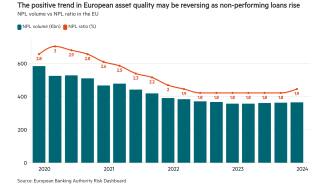This article is part of The Banker’s Special Report, Digital transformation across European banking groups, in association with Backbase.
Once considered to be trailblazers in the adoption of advanced technologies, banks are now more often identified as laggards, particularly in terms of wholesale digital transformation. Most banks are still in the early stages of adopting technologies such as distributed ledger, machine learning, artificial intelligence and cloud computing that have transformed other industries.
Further reading
However, as the world continues to battle the Covid-19 pandemic, the limitations of the current banking landscape have been laid bare. Never have the real-time, 24/7, agile and flexible environment that digital transformation promises been more appropriate.
Consultancy McKinsey believes there is “no going back” for Europe’s banks following the pandemic. During lockdown, banks had shown what was possible in terms of speed and innovation, with many becoming agile “overnight” as thousands of employees worked from home. Now is the time for banking executives to reimagine how their institutions operate, the consultancy stated in a paper published in May. “Bold vision and disciplined execution on a set of key imperatives will ultimately differentiate the leaders from the laggards as this crisis abates,” it said.
The pandemic triggered a range of new financial needs, particularly around liquidity, for many retail and business customers. “Banks need to strengthen their advanced analytics skills to identify which customers they can feasibly serve and then create a personalised offer for them. Small businesses might also be interested in liquidity advice offered as a subscription service,” said the report.
Customer behaviour also changed, with significant increases in digital banking and online purchasing. A McKinsey survey of 200,000 Europeans during May 2020 revealed that digital adoption jumped from 81% to 95%; under normal conditions, such a rise would take two to three years, the consultancy says. Another survey from the consultancy identified a 10% to 20% rise in digital banking across Europe during April alone. “Such a jump in adoption opens the door for banks to turn digital channels into real sales channels, not just convenient self-service tools,” said McKinsey.
To do this, many banks are adopting cloud-based platforms and infrastructures to cost-effectively modernise core technology systems.
The digital experience
The trend towards digital banking and ecommerce predates the pandemic, of course. In June 2019, Mastercard published the results of its second Digital Banking Study, which found that 84% of Europeans engaged in digital banking regularly, with 63% using mobile banking apps from traditional banks and one in five from digital-only banks, and that almost two thirds expected the demand for digital banking solutions to increase.
More than half (54%) of those surveyed said they would consider switching to a digital bank. In Hungary, 28% said they would consider changing their existing bank for a digital-only one within the year, while the European average was 13%. Almost one in 10 of those surveyed were already a client of a digital-only bank. Clearly, competition is increasing and incumbent banks are beginning to feel the pressure from digital native alternatives, driving them to speed up their digital transformation programmes across their geographical footprint.
But while most incumbents are aiming for a unified digital experience, in terms of function, look and feel for customers, the journey for each banking group will not necessarily be the same, says Dr Edwin Van der Ouderaa, senior managing director, financial services digital and analytics at Accenture.
“There are differences between countries across Europe. Consumers differ in what they think something should look like. Also, no countries have the same regulation,” he says. “Creating a common denominator across Europe, or even across central and eastern Europe [CEE], is a huge challenge for banks. They need to find a way of managing the differences on top of a shared technology stack, rather than creating solutions from scratch for each country.”
Jouk Pleiter, CEO of Backbase, calls this a “platform approach”. “Banks should start small but with a common platform, which will create a seamless customer journey usable across multiple countries,” he says.
Different speeds
Michael Wodzicki, partner at Deloitte Consulting in Poland, points out that the digital maturity of individual banks within European banking groups varies significantly across both western Europe and CEE. “Banking groups’ digital offerings are mostly driven by the local markets where they operate; they most often take a multi-speed and varied approach,” he says. For example, Deloitte identifies Turkey and Poland, along with Russia, Spain and Switzerland, as “digital champions”: countries with financial institutions that offer a wide range of functionalities relevant for customers and a “compelling user experience”.
OTP Bank, for example, operates in 12 markets across the CEE region and has been highly acquisitive in the past few years. “We operate in a diverse geographic area – politically, legally and culturally. Individual countries are on a different level in terms of using banking services, and how they access digital facilities. Over the years, we have learned how to cope with these differences,” explains Tibor Johancsik, OTP Bank’s deputy CEO in charge of IT and bank operations.
“Of course, when acquiring a bank in a new country, we have to carry out thorough research to get to know our customers better, as we have to understand their expectations and needs. Also, we have to get closer to our new local colleagues to enable smooth co-operation with them and also to learn about their experience and needs,” he adds. OTP Bank is planning to standardise its IT systems to drive efficiencies across its countries of operation.
Mr Wodzicki says that some leading banking groups are investing in scalable cross-country platforms and programmes to foster revenue collaboration and share IT development costs. “However, banks should not underestimate the effort required to deliver tangible results from such programmes,” he adds. “The current trend to cloud migration seems to be offering new opportunities for a more coherent international approach.”
The aim for multi-country banking groups should be to improve user experience (UX) across all their markets, but not necessarily have the same UX across multiple countries, Mr Wodzicki says. One way to achieve this, while also making UX more consistent, is to introduce a common design system. “A design system provides the same foundation for every market, which can then be aligned to local market specifics. This approach can not only improve user experience, but can also contribute to reduced time to market and lower product development costs,” he adds.
Transformation strategy
Lisa Quest, UK head of public policy at management consultancy Oliver Wyman, identifies three archetypes of digital transformation:
- demand aggregator;
- platform provider; and
- component supplier.
Demand aggregators engage in refined customer segmentation, based on the use of behavioural science and extensive customer research. Platform providers create an ecosystem of partners to address a broad range or specific needs of customers. Component suppliers take a ‘plug-and-play’ approach, providing products to demand aggregators.
“The power dynamics in banking are changing and banks are transforming, with some rebranding themselves as technology firms,” says Ms Quest.
Digital transformation is complex and means different things to different people, she adds. “Digital transformation for the top banks is focused on improving data and customer experience, as well as operational efficiency. Banks are focused on their internal cost bases, because challenger banks can run current accounts for a fifth of the cost a traditional bank incurs.”
Many banks have struggled with digital transformation projects because they attempted to do too much at once. “A large proportion of these programmes proved difficult to finish as they would go off-track and never deliver an end outcome. Big banks are beginning to learn from technology firms that the key to success is to deliver value on a regular basis,” says Ms Quest.
Digitalising one product or function at a time would deliver much more value than attempting to digitise a whole bank, she adds. “Digital transformation should be about creating new value, reducing internal costs or risks, or offering better value to customers.”
Mr Pleiter agrees. “Many of our clients start in one country, with one or two major headaches, and solve them on a common platform. In that way, they have a lot of reuse across their operations, plus a single view of the customer and easy cross-channel transitions,” he says.
The legacy hurdle
CEE banks have the opportunity to leapfrog technologies, says Oliver Wyman’s UK head of digital Deborah O’Neill. “There are increasing levels of mobile adoption in eastern Europe and Russia, and investment in innovation. More traditional payment approaches such as pay on delivery meant that some banks and retailers in the region didn’t develop traditional online applications so will be able to leapfrog to wallet-based payment opportunities.” They are also getting better at using technology and collaborating with digital innovators, she adds.
Enrico Camerinelli, senior analyst at Aite Group, agrees. “Banks in eastern Europe have the opportunity of moving to digital systems much faster than those in the west, as they do not have the same huge back office installations of legacy technology. By adopting application programming interfaces and open banking, they can decouple from the complexity of silo-based systems.”
In a 2018 report, ‘The Rise of Digital Challengers’, McKinsey identifies 10 countries in the CEE region – Bulgaria, Croatia, the Czech Republic, Hungary, Latvia, Lithuania, Poland, Romania, Slovakia and Slovenia – that it considers “digital challengers”. These countries have strong potential for growth in the digital economy and challenge other relatively small countries with high digitisation rates (“digital frontrunners”) – Belgium, Denmark, Estonia, Finland, Ireland, Luxembourg, the Netherlands, Norway, and Sweden.
Banks in the challenger countries are less bound to legacy systems. “In CEE, financial transactions based on payment cards entirely bypassed the use of cheques. Today, countries in the region boast one of the highest adoption rates for contactless payments in the world. Thus, while it may be more difficult for digital challengers to compete in the traditional economy, they enjoy a level playing field in the digital economy,” says the McKinsey report.
Some banks consider the CEE region as lucrative, says Accenture’s Mr Van der Ouderaa, and rather than entering the market via an acquisition, have developed digital “attacker” operations in the form of neobanks or digital-only banks. “Several large banks have done this and approached markets like a fintech. There’s been varying levels of success for this approach as it is difficult and requires a significant marketing spend,” he says.
Lessons learned
During the past five years, attitudes have changed towards digital transformation, says Mr Van der Ouderaa. At CEO level, bank executives acknowledge its importance. What is more, institutional investors evaluate the chances of a bank’s growth based on its digital transformation strategies. “If a bank does not have a credible digital strategy, it is unclear how it can grow its earnings or protect its margins. Digital transformation enables banks to reach new sets of customers with a modern product set that protects margins and also creates new revenue streams,” he says.
Lessons have been learned from attempts at transformation, he adds. Post-pandemic, transformation projects are likely to focus on end-to-end projects based around straight-through processing at the back end and digital products at the front end. “Covid-19 is accelerating the move to e-commerce; by 2025 half of the global economy will be conducted via digital means. This is no longer a nice-to-have for banks; they will have to be able to interact with platforms and e-commerce sites,” says Mr Van der Ouderaa.
Aite Group’s Mr Camerinelli says it is clear that digitalisation requires more than “moving from paper to digital”. The real value in digital transformation, he says, is creating digital workflows that enable documents to be created and that enable their exchange, modification and execution in a digital fashion. “It’s not all up to the banks to do this; corporations also need to do their homework and shouldn’t wait for things to happen. They need to change and improve their own business processes.” He suggests this would best happen as a co-creation effort with banking partners.












